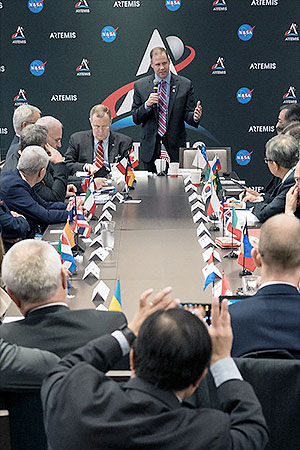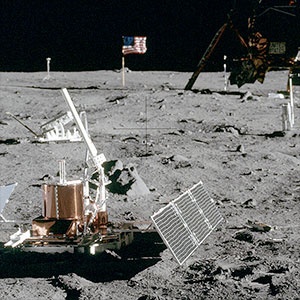May 15, 2020 — NASA is inviting international partners to join in its return to the moon, but only if they first agree to a set of principles, including the protection of historic sites already there.
The U.S. space agency on Friday (May 15) outlined the "Artemis Accords," its proposed framework for the next era for lunar exploration and utilization that fosters "a safe and transparent environment which facilitates exploration, science and commercial activities for the benefit of humanity."
"The Artemis Accords were basically conceived to make sure that people that join the Artemis program are in agreement on very basic principles of safety in space," NASA Administrator Jim Bridenstine said, addressing a meeting of the Regulatory and Policy Committee of the NASA Advisory Committee on Friday morning.
Under the Artemis program, NASA is working towards landing the first woman and the next man on the moon by as soon as 2024. Rather than racing other countries as it did 50 years ago during the Apollo program, NASA is seeking to partner with other to achieve the goal together.
"If you think about the way we went to the moon back in the 1960s, it was pretty much the United States of America alone," said Bridenstine. "We didn't have the international collaboration that we have today."
"With the International Space Station and with the inter-governmental agreements that were formed for the creation of the International Space Station, we have amazing international partners and we have a legal framework by which we can all work together," he said. "That inter-governmental agreement, the IGA, has been very effective for the International Space Station and for that reason, we are taking that agreement all the way to the moon."
As outlined by NASA, the Artemis Accords include 10 principles for international cooperation, including that all activities be conducted for peaceful purposes and that partner nations agree to operate in a transparent manner with regard to their own policies and plans. The countries also must agree to support interoperability between spacecraft and other hardware systems "to the greatest extent practical" and that they will commit to taking all reasonable steps to assist astronauts who are in distress.
Partner countries must also agree to registering the objects they launch into space, mitigate orbital debris, permit for resource extraction and utilization, release scientific data freely to the public and to deconflict their individual activities on the moon's surface by establishing and respecting "safety zones."
"When it comes to activities on the moon, we need to be able to deconflict," said Bridenstine. "If you are operating on the surface of the moon, doing specific things, anybody who comes into an area around where you are operating has to abide by certain things: transparency, that they are not going to interfere and that they are going to operate safely."
The same "due regard," Bridenstine said, would also apply to the places we have been before and the objects we left there.
"We want to be able to protect heritage," he said. "On the surface of the moon, we have the Apollo landers, but we had landings with robots even before Apollo. We want to be able to protect those sites on the surface of the moon, so if we are enabling people to go to the moon with us, we want to make sure that those sites are all protected."
The principles of the Artemis Accords were based on the articles of previous international agreements, including the Outer Space Treaty of 1967, which created the initial framework for countries to work in space and on the surface of other celestial bodies. NASA also cited the Registration Convention and the Space Debris Mitigation Guidelines of the United Nations' Committee on the Peaceful Uses of Outer Space.
"These are very basic principles. They are, in fact, the very principles that are enshrined in the Outer Space Treaty," said Bridenstine. "We are not doing anything to change or modify the Outer Space Treaty. What we are saying [is that] we need the Outer Space Treaty to be the framework within which, when we go to the moon safely, transparently [and] for peaceful purposes, we all have this basic set of principles that we can agree to as we go to the moon."
NASA next plans to present the Artemis Accords to its international partners that have already expressed an interest in taking part in the Artemis program, including the Japan Aerospace Exploration Agency (JAXA), the European Space Agency (ESA) and the Canadian Space Agency. Participation though, will be open to more than NASA's existing partners in the International Space Station, said Bridenstine, citing interest from the Australian Space Agency, the United Arab Emirates (UAE) and Luxembourg as examples. |
|

NASA Administrator Jim Bridenstine, seen here speaking during an October 2019 multilateral meeting of the heads of space agencies, has outlined the Artemis Accords, a framework the joint exploration and utilization of the moon under NASA's Artemis program. (NASA)

Among the principles of NASA's Artemis Accords is the protection of the Apollo landing sites and other areas of historic importance to humanity's heritage on the moon's surface. (NASA)

Artist's concept of an Artemis astronaut stepping onto the lunar surface. NASA's Artemis program aims to land the next man and the first woman on the moon by 2024. (NASA) |
